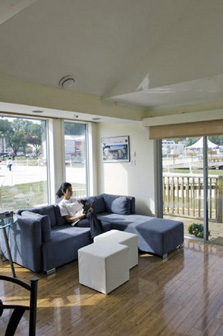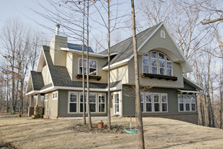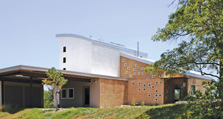

The National Association of Home Builders (NAHB) and the DOE Energy Efficiency and Renewable Energy Office awarded Team Canada a first-place plaque for building the most energy-efficient house at the 2005 Solar Decathlon.
(Credit: Stefano Paltera)

Built by Stitt Energy Systems of Rogers, Arkansas, winner of 15 EnergyValue Housing Awards, this home demonstrates the builder's unwavering passion for energy conservation and use of solar energy technology. It is the 2006 EnergyValue Housing Award gold winner in the Custom Home, Moderate Climate category. This home was also chosen as NAHB's 2007 Green Building Project of the Year.
(Credit: NAHB Research Center)

Ferrier Custom Homes of Fort Worth, Texas, NAHB's 2007 Green Builder Advocate of the Year, built this home. It won the 2007 EnergyValue Housing Award gold award in the category of Custom Home and Hot Climate. Features include sustainable materials, near-zero energy consumption, and a solar water heating system.
(Credit: NAHB Research Center)
Solar Decathlon 2007
The National Association of Home Builders
The National Association of Home Builders (NAHB) is an enthusiastic supporter of the innovative, environmentally friendly ideals and building technologies promoted through the Solar Decathlon. We are also pleased to sponsor a special award—separate from the competition itself.
NAHB has promoted energy-efficient building techniques for years. When energy prices soared in the late 1970s, we were the first organization to step forward and introduce voluntary energy guidelines for new residential construction. Over the next decade, the energy efficiency of new housing about doubled.
In January 2005, NAHB introduced its voluntary Model Green Home Building Guidelines to the public. In 2006, NAHB took those efforts a step further by starting development on the ANSI National Green Building Standard. This is a collaborative effort of NAHB and the International Code Council. Like the guidelines, the National Green Building Standard (NGBS) is designed to help mainstream builders incorporate environmental practices into every phase of the home-building process while still placing a premium on affordability. The green building practices contained in the NGBS include many of the building techniques you see in the Solar Decathlon houses on the National Mall. The NGBS is scheduled for publication in early 2008. NAHB is also in the final stages of developing the National Green Building Program, which aims to further advance mainstreaming voluntary green practices into the housing industry. This program helps communities and builders provide the infrastructure needed to implement the cost-effective NGBS practices community wide.
Although energy efficiency is a key component of the NGBS, we also emphasize careful lot planning and site design, using building resources effectively, conserving water, promoting healthy indoor air quality, and educating new homeowners on how to best use the green features of their new homes.
Our members—all 235,000 of them—will construct about 80% of the more than 1.45 million homes projected to be built in the United States this year. NAHB is committed to advancing energy-efficient building techniques and is excited about our involvement in the 2007 Solar Decathlon.
